LP74
| Group: Tragowel | Mapped Soil Type: Kinypaniel Clay Loam. |
| General Landscape Description: Irrigated pasture within a flat plain. Original vegetation included River Red Gum (Eucalytpus camaldulensis). | |
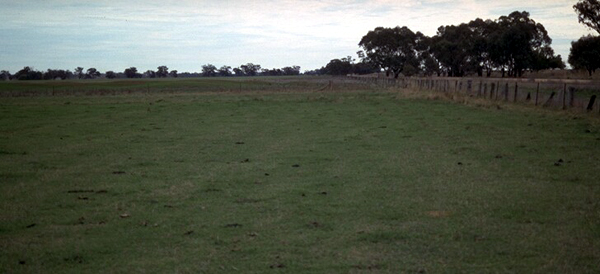 LP74 Landscape |
Soil Profile Morphology
Surface Soil
| A1 | 0-10 cm | Dark yellowish brown (10YR4/4) with rusty root channel mottling; very fine sandy clay loam; hardsetting surface condition; weak coarse blocky structure; very strong consistence dry; pH 6.7; sharp and smooth change to: | 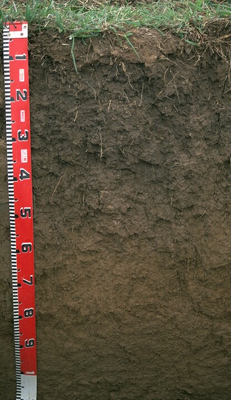 LP74 Profile |
| Subsoil | |||
| B21 | 10-50 cm | Brown (10YR4/3); heavy clay; moderate coarse prismatic, breaking down to moderate coarse blocky structure; very firm consistence moist and sticky when wet; contains very few (<2%) soft manganese stains; pH 8.0; gradual and wavy change to: | |
| B22 | 50-80 cm | Yellowish brown (10YR5/6); medium heavy clay; contains weak slickensides; weak consistence moist; contains very few (<2%) soft manganese stains; pH 8.1; clear change to: | |
| B23 | 80+ cm | Yellowish brown (10YR5/4); fine sandy light clay; strong fine polyhedral structure (shiny faced peds); weak consistence moist; contains a common (10-20%) amount of soft manganese stains as well as patches of black sand; pH 8.6. | |
Key Profile Features
- Hardsetting surface soil.
- Strong texture contrast between surface (A) horizon (33% clay) and sodic subsoil (B21) horizon (66% clay).
- Accumulation of soft manganese throughout the subsoil.
- Vertic properties (ie. significant shrink-swell characteristics).
Soil Profile Characteristics
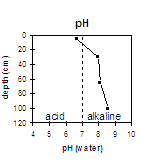 | 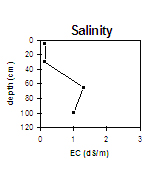 | 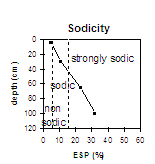 | 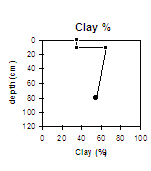 |
The surface soil is slightly acid. The subsoil is mod-erately alkaline becoming strongly alkaline at 1 metre | The salinity rating is low becoming very high at 60 cm. | The surface soil is non-sodic. The subsoil is sodic becoming strongly sodic at 45 cm. | At 10 cm the clay percentage increases by 30 %. |
Whole Profile
- A very positive feature of this profile is that it has moderate inherent fertility in the surface and a high inherent fertility in the subsoil. This is very beneficial to plant growth.
Surface (A) Horizon
- The surface soil is hardsetting and has a high fine sand content (29%). When cultivated in a dry condition it will become ‘powdery’ and subsequent rainfall may result in surface sealing occurring. Soils such as these rely to a large extent on organic matter for maintaining aggregation. The levels of organic carbon measured at the pit site (which may or may not be representative of the whole paddock) is low. Organic matter levels will build up under pasture but will decline if cropping takes place. Practices such as residue retention, minimum tillage and including pasture rotations could be utilised if cropping takes place in order to build up organic matter, improve aggregation as well as assist in the low water holding capacity and reduce erosion risk.
- The surface soil is fairly shallow (10 cm) which provides a shallow rooting environment for many plants as the subsoil is restrictive to root growth. Infiltration of water is also likely to be restricted on top of the more clayey subsoil. This could explain the rusty root channel mottling that was observed in the surface soil indicating that water has been trapped in old root channels.
- Although the surface soil is non-sodic it has a rating of 5 which is very close to sodic. The presence of strong dispersion after remoulding indicates that structural degradation (e.g. surface sealing, increased cloddiness) may occur if the soil is cultivated or overstocked in a moist to wet condition. Also, raindrop action on bare surface soil may also promote dispersion and exacerbate the hardsetting condition. Surface cover should be maintained to protect against raindrop damage. The use of gypsum may assist in ameliorating the surface soil and decreasing the hardsetting condition.
Subsoil (B) Horizons
- The subsoil is moderately alkaline becoming strongly alkaline at 1 metre. This suggests that some nutrients (e.g. iron, manganese, zinc, copper) may be poorly available to plants and that deficiencies are likely to occur. Deficiencies can be determined by plant tissue analysis.
- The coarsely structured subsoil is sodic becoming strongly sodic at 45 cm and has a low exchangeable calcium to magnesium ratio (i.e. 0.7). Slight dispersion occurs as a result (complete dispersion after remoulding) restricting root and water movement. Deep ripping into the subsoil would help to break up the physical structural problems and the application of gypsum would help to neutralise the chemical sodic problems. This expensive option would firstly depend on expected crop yield and also on adequate rainfall, to wash the gypsum down the deep rips into the subsoil. Gypsum can also be added to the surface without deep ripping, but it would require more time to wash the gypsum down to the subsoil and less of it would probably make it.
- The subsoil displays vertic properties (ie. slickensides) which indicates that significant shrinking and swelling occurs with wetting and drying cycles. This may disturb the roots of some plant species and interestingly, we observed that roots ran along flat horizontal plains. The shrinking and swelling also has engineering implications (e.g. disturbance to building foundations and fence lines).
- The subsoil becomes very highly saline at about 60 cm and is likely to restrict the growth of deep rooted salt sensitive plant species (e.g. faba beans, linseed, chickpeas and lupins).
Comments:
- The site is irrigated and the water table is one and half metres below the surface.
- The landholder states that the soil is equally good as LP75 and averages 25 bags.
Notes:
Profile described by Mark Imhof, Sonia Thompson and Paul Rampant, May 1995.


